The 15th annual Automotive Logistics Global conference, held at the MGM Grand in downtown Detroit, brought senior OEM, tier supplier and logistics provider executives to discuss ways of coping with the current growth and changes across the North American network. Most anticipated growing complexity, an increasingly important Mexico, and the deep freeze that could return this winter.

“We’re seeing a host of vehicle launches and minor model changes, all of which require changes to our inbound logistics network,” said Kevin Wade, senior staff administrator for logistics at Honda North America. “Whereas once we made adjustments every quarter or so, now we are rerouting and reengineering every one or two weeks."
- Supply chain strains
- Logistics is people to people
- Winter contingency
- State logistics investment in Mexico
- Border waves
- Export routes
- Disruption ahead
More news stories
from Motown
Check back for regular updates as stories are added
- Rising supply chain complexity
- Lesson from the 'polar vortex'
- Pressure for outbound innovation
- Spare parts speed versus reliability and cost
- Buying more standard packaging
- Honda manages the lower tiers
- Automotive is a logistics benchmark in Mexico
- Regulatory impacts
- Senior panel roundtable – relentless logistics
Click here to watch live recordings of selected sessions
Click here to follow the twitter feed from this event #alg14
Nissan has also seen huge growth and much added complexity, with each of its plants producing multiple models with derivatives, according to Ben Shain, director of logistics at Nissan North America. The carmaker is seeing changes to its network as its supply chain simultaneously becomes more global, including parts from Asia, Europe and Mexico, along with new regional suppliers in the US. Shain pointed out that moving production of the Nissan Murano from Japan to Canton, Mississippi was leading to a significant increase in new suppliers across the midwest, as well as the southeast.
“We’re managing more than 1,000 deliveries daily [in the US], and each one is depending on quality in delivery and packaging,” said Shain.
He added that the increasing complexity meant more risk relating to weather, currency and transport delays. “It’s hard for a logistics manager to sleep at night.”
In Mexico, the story just gets bigger and bigger, including recent plans announced by Mercedes-Benz and Infiniti, BMW and Kia. While there are continuing capacity concerns for material suppliers, rail, road and port infrastructure, as well as the US-Mexico border, there also continues to be many signs of investment and growth. On the second day of the conference, the keynote speaker, Miguel Márquez, governor of the state of Guanajuato, outlined just how significant the automotive industry and its accompanying logistics infrastructure is for the state.
“Without logistics, there would be no business,” Márquez told delegates, detailing a host of large infrastructure and logistics projects in the state.
The expansion in North America is not only evident for carmakers or large-scale infrastructure. Logistics companies are also clearly scaling up, including both organic growth and acquisitions. One notable example has been the lightning rise of XPO Logistics, which has acquired some 13 logistics companies and grown from $175m in revenue three years ago, to more than $3 billion today, according to chief executive officer Bradley Jacobs. Jacobs also said that the company expanded 49% organically in the last quarter. XPO is now the largest express carrier in North America for automotive, and has also emerged as a major intermodal player for cross-border flows with Mexico.
Another example is Jack Cooper, which following its acquisition of the Allied Automotive Group last year, is now the largest car carrier on the continent. The company’s combined fleet of trucks is now around 2,500, including some idle capacity, according to Alex Meza, chief commercial officer.
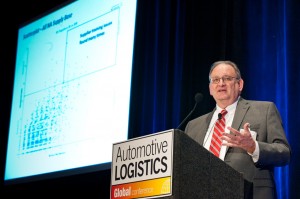
Although there are clear trends in North America towards more regional sourcing and ‘near-shoring’ of production, the conference revealed just how complex and global the supply chain is becoming. Ford, for example, is seeing pressure in its supply base and logistics, driven in part by 23 new model launches or updates this year in North America alone. Bill Storves, supply chain and plant operations manager, revealed the increasing globalisation, supply and shipping locations for the carmaker’s production: globally Ford now manages 130,000 part numbers in current production, including 1,100 suppliers from 8,500 ship sites.
Taking the current Ford Focus model in North America as an example: of 480 suppliers, 30% are within 250 miles (400km) of the plant, while another 17% are between 250-1,000 miles. However, 53% are greater than 1,000 miles away, including 34% further than 2,500 miles. In the previous North American Focus programme, which was not so closely aligned to the European version as the current one, just 13% of parts were based 2,500 miles or more.
“With a supply chain like this it’s all about logistics, logistics and logistics,” said Storves.
However, Storves admitted that many suppliers “have the opportunity to perform better” when it comes to meeting pickup windows, and he pointed to strained production capacity, urging suppliers to make better use of Ford’s KPI and performance tracking systems. Others admitted that they were seeing similar issues. Elliot Swiss, director of inbound logistics for General Motors, said that the past year had been tough for premium freight in some parts of North America as suppliers struggled to keep pace with production, while driver shortages, trucking regulations and weather issues impacted delivery performance.[sam_ad id=6 codes='true']
“The hardest part for me is when a tier one can’t ship on time. And there is also this grey area between premium freight and normal routed transportation, where you plan four shipments a day and the truck gets there at noon, but is still at the supplier plant at four in the afternoon,” said Swiss. “So instead of running 20 trucks a week you’re running 30. However, the supplier doesn’t put their hands up and say that they can’t keep up, which would trigger an expedited shipment and a different process. That for me is the biggest challenge.”
Thomas Isaacs, director of strategic logistics for NAFTA at tier supplier Grupo Antolin North America, said that he was seeing lower tier suppliers struggle with wide variations in supply and production, and resulting problems in logistics. “We have the identical situation [to GM] as far as what is the difference between adding a truck, subtracting a truck, versus expediting a truck,” he said. “We have had trucking carriers who said we no longer want to handle your ex-works lanes because some of our [tier two] suppliers couldn’t hit a pickup time like the broad side of the barn door.”

Dannette Beltinck, global logistics manager at tier supplier Inteva products, also admitted that she was seeing some global shipping issues, particularly in moving products from the US to South Africa, as well as from India to Brazil.
The human factor
To deal with such issues, logistics executives pointed to the importance of their relationships with third party logistics provider and lead logistics providers (LLP). Isaacs said that Grupo Antolin had brought in an LLP as part of a centralisation of logistics management – bringing logistics and carrier management away from plants and towards a central logistics function – during the past five years. “I adore my LLP,” he said. “We are now able to look much more strategically at logistics, including doing things like forecasting, modal studies, EDI and VAV engineering. Our LLP helped with all of that.”
But tier suppliers also stressed the importance of working directly with trucking carriers to obtain the necessary capacity, particularly since many lack the scale and buying power of General Motors or Ford, for example. Mike Silvio, director of supply chain management at tier supplier Cooper Standard, said that carriers with assets dedicated to carmakers were less likely to get trucks for Cooper Standard in time. As a result, the company avoids brokers and tries to work more with companies that own assets.
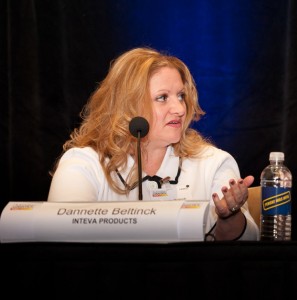
“He might only have a few trucks but he never fails because I am his biggest and best customer,” Silvio said. “Logistics is still about people. Find a carrier that wants to be in business with you and treat him well, and he will take care of you before other people who treat him poorly.”
Dannette Beltinck agreed that she and her team did the same thing, including taking pictures of trucks on the side of the road or writing down their ID numbers. “I’ve been doing that since starting out in dispatch and it is how I have gained hundreds of carrier contacts,” she said. “I’m the first one to call up a carrier at 2am because he has a hot load. I want to know how he is doing and where he is. This surprises truckers because customers don’t call them.
“That is the kind of stuff that keeps those relationships strong and my lines running,” she added.
Cars have to move, weather or not
The weather issues and resulting delays were of course an even bigger issue for outbound logistics this past year in North America. As rail velocity decreased, ground inventory of vehicles awaiting shipments grew to more than twice as high as usual, and did not return to normal levels until after the summer shutdowns at plants. While velocity and performance on railways have now stabilised, many logistics managers are looking to contingency plans ahead of the approaching winter, which some forecast to be as bad as last year. Toyota’s national manager for strategic planning and communication, Brian Mason, said that the carmaker was already looking at adding paved space for storing extra vehicles at some plants or planning off-site parking in case of further delays at plant and rail yards.
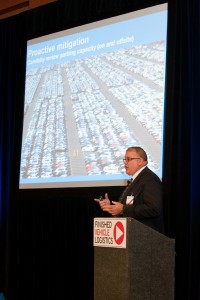
Such preparation and contingency planning was evident for many OEMs and logistics providers. Richard Blank, vice-president of finished vehicle services for Vascor, said that many carmakers were now issuing requests for quotes or bids, which include provision for off-site temporary parking near to plants and ports. Ben Shain said that he and his team at Nissan were meeting frequently with both inbound carriers and outbound providers to plan alternative routes or backup plans should there be weather-related delays.
Bill Cook, head of worldwide logistics and customs for Chrysler Group, admitted that the weather presented issues for his company too, but that it was also “part of our business in a global, 24/7 supply chain”.
“We’ll do some tactical planning and tune up some things ahead of the winter. But it is important that I talk to my supply base regularly and that we get notifications sooner. We have to make sure that nobody is asleep at the switch.”
There were also encouraging signs of investment and further planning among railway providers. Dave Fleenor, assistant vice-president of automotive at BNSF, revealed that the company is currently investing in 160 miles of double rail tracks in North Dakota, a state which, on its own, accounted for 20% of BNSF’s growth in the last year across its business segments. It is an expansion that will free up considerable capacity across the network. BNSF, along with other railways, is increasing its fleet of railcars and adding more automotive yards, including an expanded automotive yard in Big Lift, Colorado and double switching capacity at its yard in Kansas City.
Fleenor said that this investment, combined with better planning around potential hot spots and bottlenecks, and lower growth in other commodities, should make the next winter “much better”.
“We are committed to restoring service,” he said.
Alex Meza reiterated Jack Cooper’s call for an increase in the length of car carriers to 80ft (24.4 metres) and an increase in weight of 80,000 pounds to 88,000 (39.6 tonnes), which will allow carriers to increase their load by one vehicle. But as well as the increases, he also said there was scope for better collaboration between railway providers and truckers to plan around capacity bottlenecks or address urgent blocks. “We need to work together to have an escape valve. It should mean truckers and railroads speaking more to each other,” said Meza.

Once again, Mexico was very much on the mind of many executives, as more carmakers and tier suppliers add production capacity in the country. There continues to be some concern around rail and port capacity, in particular around truck capacity at the US-Mexico border. However, the conference also had an insight into just how important Mexico’s regional governments consider the automotive industry, with substantial infrastructure development underway.
Miguel Márquez, governor of the state of Guanajuato – one the fastest growing states for automotive in the country – pointed out that although the state has a central and strategic location in central Mexico, it could not rely on its locations or even Mexico’s free trade agreements alone. “We depend on our infrastructure and our logistics to be connected to world markets,” he told delegates.
Guanajuato represents Mexico’s impressive rise as an automotive production and export centre in North America. As the new plants for Honda in Celaya and Mazda in Salamanca (which will also build Toyota models) reach capacity, along with General Motors output in Silao, vehicle assembly is expected to grow from 280,000 vehicles per year to more than 730,000. Powertrain production is growing too, including a Volkswagen Group engine plant in Silao and new powertrain plants for Honda. Engine output is expected to grow from 800,000 to 1.2m units a year, and transmissions from 1m to 1.75m. Other component production is rising too, including tyre manufacturing from Pirelli, and more than 150 tier suppliers.
Total exports from the state have grown from $200m per year in 1990, to more than $16 billion expected this year.
Márquez outlined a number of significant projects that would directly support production, distribution and exports for automotive. This investment includes 500km (320 miles) of new roads, a four-lane highway to Silao, and a new highway linking the city of Leon to Salamanca.
The state is also home to one of Mexico’s largest and most expensive infrastructure projects in Celaya, where a new rail bypass and interchange is being built to serve both Class A railways in Mexico: Ferromex and Kansas City Southern de Mexico (KCSM). Brian Bowers, vice-president of logistics services for Roche International and a former executive at KCS, said that the project was one of the most important and challenging rail connections in Mexico, and indeed North America.
“Until the bypass is completed, we will be on a logistical ledge,” Bowers said.
While Márquez pointed to good links by road and rail to Mexican ports on both the Pacific and Gulf coast, he also highlighted the Guanajuato inland port project, in which the state has invested $150m. About 60% of the 82 companies onsite are currently doing automotive production or logistics activities at the inland port.
“We are investing to allow companies to take full advantage of Guanajuato’s strategic location,” said Márquez.
Automotive Logistics is happy to announce its inaugural Automotive Logistics Mexico conference, which will be held January 27-29 2015 in Mexico City at the Marquis Reforma hotel. Details can be found by clicking here.
While the investment in Guanajuato and other states in Mexico is significant, there was still concern that overall the country may not keep up with automotive growth. Trade at the Mexican border has indeed grown exponentially. Scott Grady, senior vice-president at Landstar, said that trade crossing had surpassed 60,000 per month, with more than 60% of those crossings by truck. However, 38% occur at one of the three bridges in Laredo, Texas, which can lead to congestion. Delays mean not only higher inventory costs and potential disruption to manufacturing, but Grady pointed out that 90% of all instances of cargo theft for Mexico occurred while goods were not moving.
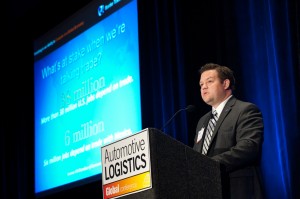
Brian Bowers agreed, pointing out that the discussion around rail crossing at the border was about much more than infrastructure; handling and customs need big improvements, too.
“If you watch how trains connect at Laredo, you see evidence of the need for process change. The train comes to the middle of the bridge and stops, the Mexican train crew gets out, and then the US crew walks down the train, inspects it, and eventually pulls it out,” he said. “If the railroads at the border could create a process that clears the bridge before crew changes, you could dramatically increase the throughput.”
As truck crossings increased, Brian Bowers indicated that there might even be some overcapacity for intermodal crossings. Not long ago there was only one intermodal route across the border, which was between Union Pacific and KCSM; today there are four. “Four is probably too many. I think that over the next 12-18 months, one of these crossings will probably close,” he said, pointing to the importance of cargo density for intermodal transport to be viable.
Bowers stressed that it was important to balance multiple modes across the border, including rail, carload, intermodal and truck. “When disruptions happen at the border, and they inevitably will, it is important to have as many options as possible,” he said.

“We’re still behind the curve in infrastructure, but we’re moving in the right direction,” he said.
Looking for options northbound
For outbound logistics, the themes for Mexico were similar to those that have been discussed over the past two years, including difficulty in obtaining sufficient railcar capacity for exports, as well as interest in more short-sea options. Matt McCoy, operations manager for General Motors, admitted that while rail capacity out of Mexico had been better than other parts of the North American network this year, “we haven’t seen the improvements that we would have liked to see”, citing inconsistent service and lead times in particular.
The issues have led GM to change its network. While two years ago it moved 100% of its vehicles out of Mexico to the US and Canada by rail, using other modes only as backup, today the carmaker has introduced bi-monthly sailings to both the east and west coast. In some instances, GM has even resorted to direct trucking to get vehicles over the border.
"You have to take a positive approach. It’s challenging in Mexico but the experience is also very rewarding" - Richard Blank, Vascor Logistics
McCoy, like Toyota’s Brian Mason, did not advocate a wholesale or huge shift in modes, but did express the need for better contingency planning, as well as for more short-sea options. “Ideally we could move our sailings from twice a month to weekly sailings,” McCoy admitted.
There does appear to be signs of growth and investment in such options, however. Ben Buben, executive director of operations and business development for Pasha Automotive Services, said that his company was looking to help support more short-sea shipping services between the US and Mexico. The company is adding processing facilities at Port Manatee, Florida; Portsmouth, Virginia and Philadelphia, Pennsylvania to complement west coast locations (especially San Diego, California and Grays Harbor, Washington).
Richard Blank said that Vascor, which manages plant releases and inspections, and operates plant and rail yards in Mexico, has experienced labour and skills shortages in Mexico. He pointed to challenges in particular in the north of the country in finding workers, while Vascor has also contended with high turnover.
Blank pointed to difficulties in obtaining permits and clearing regulatory hurdles. In one instance, it took over four months to get official clearance to move vehicles around 400 metres. He also pointed to challenges in refinancing. “There are complex issues, as when you move money from the US to Mexico it raises concerns about money laundering, for example,” he said.
Nevertheless, Blank pointed to the company’s fast growth in Mexico, a successful suite of IT systems and plans for further expansion. “You have to take a positive approach. It’s challenging in Mexico but very rewarding,” he said.
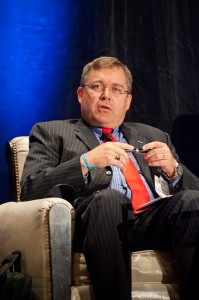
Beyond issues like the weather or market changes, there was emphasis on the constant focus on logistics and process engineering that is at the heart of managing today’s supply chain. Grant Belanger, global executive director of material planning and logistics, as well as service parts logistics for Ford, stressed again that his team was focused on “the relentless pursuit of continuous improvement and efficiency”. Behind this drive, he said, was a move towards greater standardisation in equipment, systems and processes, as well as the constant use of data to assess performance.
Bill Cook from the Chrysler Group also stressed the push toward standardisation, particularly as the Fiat and Chrysler merger leads the combined carmakers towards greater system and process harmonisation. “As we go global and expand together in regions like Asia, we have a big focus on standard processes and pulling our logistics together,” he said. “We might be behind others but it is very important to us.”
Although ‘green logistics’ did come up as frequently or perhaps in as much depth as it does in other markets, such as in Europe or China, executives still felt that their efficiency projects corresponded to the push for lower emissions and pollution. Dana McBrien, associate chief advisor for North America logistics at Honda, pointed to OEM commitments such as ‘zero waste to landfill’ at assembly plants; he also highlighted significant routing optimisation that eliminates millions of excess or empty miles. Furthermore, Honda is developing vehicles with more alternative fuels that should impact logistics.
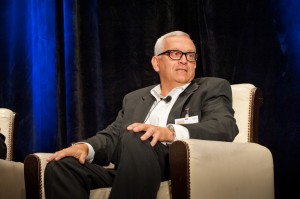
Bill Cook said that Chrysler was similarly committed to CNG. “Those living in the Detroit area will have seen that we have our own fleet of CNG vehicles. I believe that it is a very viable technology,” he said.
Belanger also stressed the potential for disruptive technology to bring further changes. He pointed out that the ubiquitous use of smartphone and tablets in personal life could eventually pervade business processes and change logistics as well. Further out, he pointed to innovations such as 3D printing and automated driving, and the implications that it could have for the entire supply chain.
But at a somewhat more mundane and yet essential level, Belanger again stressed the critical need for more flexibility and speed in the network – and the “relentless” pursuit of efficiency. “I want an agile and flexible network in which you can change routing quickly,” he said. “And I want to do it without adding excess inventory at any node in the supply chain.”
The next conference organised by Automotive Logistics will be the ECG Conference, powered by Finished Vehicle Logistics, in Amsterdam 16-17 October.
The next conference the Automotive Logistics series of events will be Automotive Logistics South America in Sao Paulo, 4 November.
The next event in North America in our series will be Automotive Logistics Mexico in Mexico City, 27-29 January.


























![Global[1]](https://d3n5uof8vony13.cloudfront.net/Pictures/web/a/d/s/global1_726550.svgz)









